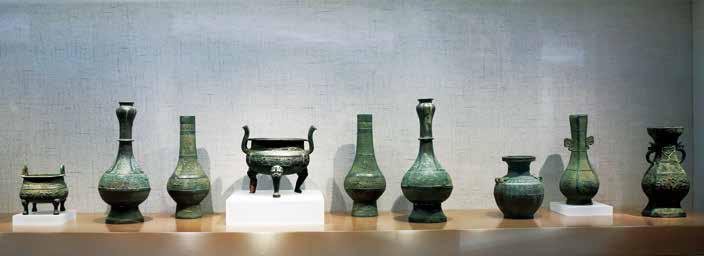Museum Honors History and Culture of Lin’an
2019-03-18YuJiji
Yu Jiji
Linan in the west of Hangzhou deserves a museum to relate its past glories. Now a district of Hangzhou, Linan made its fame in the 10th century when Qian Liu, a native of Linan and a warlord, brought peace and prosperity to Zhejiang in the chaotic years after the fall of the mighty and prosperous Tang (618-907). Historians unanimously attribute the prosperity, peace, stability of Hangzhou to King Qian Liu who founded the Wuyue Kingdom (907-978). Altogether five kings in three generations ruled the kingdom for a total of 72 years which made this part of China the richest in the country and enjoyed peace. The kingdom surrendered peacefully to the Song in 978, eighteen years after the Song Dynasty (960-1279) set itself up and unified China step by step over a long time.

臨安博物馆内文物展示。Some ancient exhibits at Linan Museum
Linan Museum, situated at 800 Tianmu Road in Linan District, measures 10,500 square meters in built-up area. The biggest cultural undertaking in Linan, it presents the history of Linan and the history and culture of the Wuyue Kingdom. It opened to the public on January 28, 2019.
The museum was designed by Wang Shu, the first Chinese winner of Pritzker Prize, the worlds top prize in architecture, and dean of the School of Architecture of the China Academy of Art based in Hangzhou. The general idea Wang adopted was that the architecture of the museum should fuse with the local landscape, culture and history. Wang was inspired by a landscape painting compositional structure in which mountains and rivers should occupy only half of a painting, which was first put forward and promoted by Li Tang, an artist of the Song. In a sense, the structure also reminds visitors of the Wuyue Kingdom which accounted in size for a part of the country. The architect put a lot of local elements in the design of the museum and was ruthlessly meticulous in supervising the construction and decoration of the museum.
Though the region loomed large in the 10th century, its history can be traced to prehistoric times. Stone-age artifacts, potteries, and animal fossils have been unearthed in Linan, indicating the traces of early human activities in Linan. Some artifacts unearthed in Linan can also be traced to the Western Zhou (1045-771BC) and the Eastern Zhou (771-256BC). The 482 pieces and sets in the first exhibition hall present a general view of he history Linan and the history of the Wuyue Kingdom.
The second exhibition hall is dedicated to the memory and glory of the royal family of the Wuyue Kingdom. Almost all the exhibits on display in this section are from the tombs of the royal family. Altogether nine tombs of the royal family have been found in Linan. The Tomb of King Qian Liu and the tomb of his grandfather Qian Zhou remained intact. The seven other tombs have been excavated in different years as of the 1950s. The exhibits include the Secret-Color porcelain, white porcelain, astrolabes, gold and silver vessels, reflecting the prosperity, technology, trade of the Wuyue Kingdom in the southeastern China.
The third hall is dedicated to temporary exhibitions for memorials, festivities, and commemorations.
Of the all exhibits, 51 pieces or sets are class one national treasures. Of the 51, the most eye-catching are a celadon incense burner with brown cloud patterns, a celadon covered jar with brown cloud patterns, and a celadon oil lamp with brown cloud patterns, indicative of the best products of the lat Tang Dynasty. The three pieces are huge in size and complex in form, indicating the difficulties in designing and manufacturing.
On July 12, 1980, some workers were digging sticky soil to make bricks at a kiln factory in a hill in the northwestern part of Linan City when they ran into an ancient tomb. It was only six meters from the Tomb of Qian Kuan, the father of King Qian Liu. The workers immediately reported this accidental discovery to the government. On August 11, archaeologists began to excavate the tomb. The digging lasted 49 days. It turned out that buried in the tomb was the wife of Qian Kuan and mother of Qian Liu, who passed away in 901 AD. More than 100 burial objects were unearthed from the tomb, including 25 celadon pieces created in Yue Kiln. It took a few years to repair the three pieces. Now people can see them at Linan Museum.
